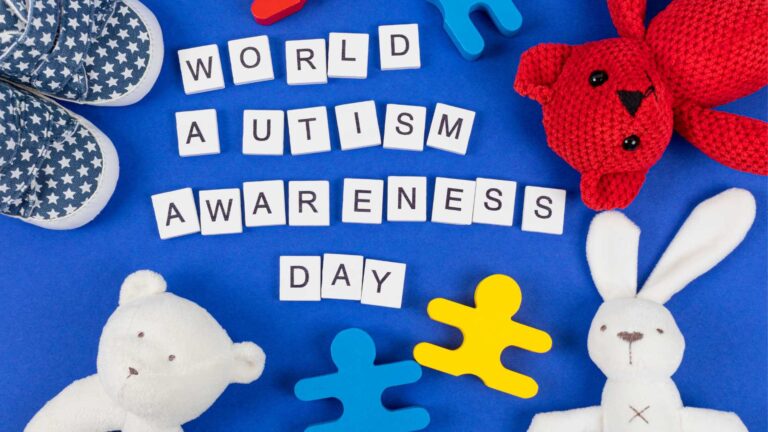Every year on April 2nd, humanity celebrates World Autism Awareness Day (WAAD) and advocates for the rights and welfare of people diagnosed with autism spectrum disorder (ASD). This awareness did not emerge suddenly and without work. The history of how this day launched and what resulted from its recognition by the United Nations spans many years and involves the efforts of numerous organizations, people, and countries.
Surprisingly, autism was not recognized as a condition a little over a century ago. It wasn’t until the 1960s and 1970s that autism research started to pick up speed, raising public awareness of the disorder. Despite this, there was a shortage of resources and assistance for people with autism and their families. The global community did not generally acknowledge their needs. Families searching for counseling or information had a difficult time during this time.
At the ABA Centers of America, we celebrate World Autism Awareness Day with all the pomp and circumstance it merits. As active supporters of the autism community, we believe that every neurodivergent person is unique and fully deserving of the love and dignity many fought to achieve. This blog will cover how we got here, from a condition often ignored to one supported by the international community.
1. The Explosion of Autism Awareness
Some organizations started promoting increased autism support and understanding in the 1990s. One such group was the Autism Society of America, founded by well-known autism researcher Bernard Rimland and psychologist Ivar Lovaas, whose study served as the basis for contemporary Applied Behavior Analysis (ABA). Their organization established National Autism Awareness Month in 1995. More families and people diagnosed with autism spectrum disorders began to speak up about their needs and asserted their proper place in society. This outpouring marked the beginning of an era of awareness.
The United Nations noticed and, in 2002, established World Autism Awareness Day by unanimous vote, marking the start of autism awareness as a worldwide concern. Unfortunately, the resolution included no recommendations about how to care for the needs of people with autism.
2. Increasing Advocacy
Autism awareness had a day, but it still had no support outside of a proclamation. The United Nations Department of Public Information quickly got to work, planning events and activities to commemorate World Autism Awareness Day and advance knowledge of the condition.
The United Nations conducted its inaugural World Autism Awareness Day celebration at its headquarters in New York City in 2006. Speaking at the event were UN representatives, autism specialists, and those on the spectrum with their families. The occasion inspired nations to take action to support people with autism and assisted in increasing awareness of autism among the global population.
Autism advocacy group, Autism Speaks started the “Light It Up Blue” campaign in 2007. Its goal was to increase public understanding of autism by encouraging companies and people to decorate their landmarks and buildings in blue on April 2nd.
In 2008, the UN established the “Convention on the Rights of People with Disabilities” in response to the increased awareness of those on the autism spectrum, their support, and the rise in diagnoses around the globe. This assembly recognized the entitlement to education, work, and full societal involvement of people with disabilities, including those with autism. More than 170 nations have ratified the Convention, which has aided in promoting the rights and inclusion of people on the spectrum worldwide.
The “World Autism Awareness Day” initiative was started in 2009 by the Autism Speaks organization and other advocacy groups. It urged governments to take action to provide early intervention services, increase access to education and employment opportunities, and fund more research into the causes and treatments of autism.
The culmination of these decades of awareness was the United Nations Resolution on Autism in 2013, which urged countries to take immediate action to meet the needs of people with autism. The resolution asked countries to offer early diagnosis and intervention services, widen access to possibilities for education and employment, and support research into the condition’s causes. In the past 100 years, we have made significant progress toward a more inclusive world.
This year, the UN will host a virtual event to observe WAAD on April 2nd, from 10:00 AM to 1 PM EST. It will feature autistic speakers from around the world discussing the new paradigm of neurodiversity and how it has led to further acceptance. You can register to celebrate together with the world here.
ABA Centers of America and Autism Awareness
ABA Centers of America is celebrating Autism Acceptance Month by encouraging those on the autism spectrum to champion the qualities that make them extraordinarily them with its “More Than Divergent” campaign.
The word neurodivergent has become popular in recent years because it can be used as a catchall to describe a vast community of people. Still, the characteristics and challenges faced by the autism community are incredibly nuanced, and no one-size-fits-all word accurately describes every individual with autism.
ABA Centers of America is rallying for the autism community to swap out “divergent” in the word neurodivergent with an adjective that more accurately represents how they define their own developmental or cognitive uniqueness.
We’re encouraging those on the spectrum and their families to declare how they are “More Than Divergent” on their social media channels with a photo or caption using the hashtag #morethandivergent.
As part of the “More Than Divergent” campaign, ABA Centers of America is launching a filter on TikTok and Instagram that takes the user through a random selector of distinctive attributes ranging from the face value to the fantastical, landing on the trait that the filter deems the most fitting for the individual. Results include 26 different characteristics, such as Neuro-Curious, Neuro-Grandiloquent, Neuro-Likes Pineapple on Pizza, Neuro-Wears Pink on Wednesdays, and Neuro-Prefers Dogs Over People. The team crafted all possible results to align with traditional autism-related dispositions, with a sprinkle of cheekiness.
Everyone on the autism spectrum has a right to happiness, self-reliance, and a fulfilling life with their family and loved ones. ABA Centers of America provides ABA therapy, the only research-backed, FDA-approved therapy for those diagnosed with autism. Through positive reinforcement and individualized plans, those on the spectrum grow their abilities and healthy coping mechanisms, setting them on the road to accomplishing their goals.
For a free consultation, pick up the phone and dial 844-923-4222 or send us a message online—Happy World Autism Awareness Day, and onwards to an autism-friendly future!







